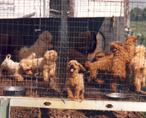 resources |
resources > commercial breeders the profit motive Commercial breeders can be large or small; the common factor is the desire to make money. This ‘profit motive’ explains, in part, why animals are bred in inhumane and substandard conditions. The fewer the expenses, the greater the profit. It’s estimated that a single dog can generate $2,000 per year in gross sales for the commercial breeder. (Example: 200 intact females x $2,000 = $400,000 per year in sales; number of breeding bitches varies by facility). It’s also estimated that it takes six months to recover the cost of one dog (based on current inhumane breeding practices and conditions) vs. five years for one cow.
Follow the money In 1996, an investigation was conducted of 100 Amish and Mennonite farmers in Pennsylvania who supply boutique dog-shop markets. Some Pennsylvania Amish and Mennonite farmers have chosen dog breeding as a form of income, similar to some of the Amish communities in Wisconsin. Government records showed that the farmers were selling about 20,000 puppies a year at $223 per puppy (wholesale; pet stores would mark up the price). That translates to approximately $4,460,000 a year in sales. “U.S. Department of Agriculture documents show that one farmer in the town of Blue Ball [Pennsylvania] sold 1,293 puppies [in 1995] for an estimated $290,000 though federal inspectors have cited his farm for numerous violations since 1992 including overcrowded cages and inadequate sanitation, pest control, feeding and watering of animals.” (New York Post; see link) To generate high profits, commercial breeders cut operational costs, such as staffing levels, veterinarian expenses and shelter conditions. As with any product, cutting or eliminating basic operational expenses results in poorer quality — animals who suffer due to substandard conditions or who become sick, physically or psychologically. This is why, in addition to the moral issue of animal neglect and suffering, consumer fraud and public health are also concerns.
The true cost of care Animal shelters, rescue groups and reputable smaller breeders recognize that proper animal care is costly and labor intensive. Veterinarian care, quality food, waste disposal and quality sheltering are expensive. Facilities, too, must be regularly cleaned and the animals must be socialized, exercised, groomed and given affection, requiring labor. This is why hobby breeders choose to breed less (having fewer than four intact females) to give individual attention to each animal. Proper levels of care also result in higher expenses, which is why hobby breeders, by definition, generate less than $500 per year in sales. Animal shelters and rescue groups rely heavily on donations and volunteers to ensure proper animal care. In October, 2007, the State of Maine seized about 250 dogs from inhumane conditions at a Buxton puppy mill. The Maine State Veterinarian Christine Fraser was aware of and involved with this case. Cost of care for the rescue was recorded. Said Fraser: “To properly care for about 300 dogs, a kennel would need to employ at least 15 people and spend about $2,500 a day. In the first month of the rescue and recovery operation, about $125,000 had been spent in total to care for the animals. About 80 percent of that amount covered veterinary expenses. The total cost of restoring the animals to good health is likely to increase. [Fraser said it will take the dogs a long time to shake kennel behavior. A few dogs still cowered shyly and backed themselves into corners, a sign that indicates the dogs were not socialized properly.]” The food was donated. (Pepper Bailard, HSUS, Massive Maine Puppy Mill Rescue Exposes Industry Ugliness.) In Minnesota, a Foley-area breeder applied to the Benton County planning commission for a conditional use permit in December 2007. This breeder has been operating for 17 years. At a public hearing, the breeder stated she has 175 adult dogs and about 265 puppies a year (72 litters each year with an average of four puppies). The breeder also stated that, besides herself, she has one other person working about four hours a day. This is 1.5 people to care for 440 dogs. NOTE: The State of Minnesota does not regulate the dog and cat industry. No State license fees are collected. No animal fund has been established to train and employ humane agents, even though commercial dog and cat breeders generate high sales at the expense of animal care.
Please email or call your State legislators and educate them about inhumane dog and cat breeding in Minnesota. Ask them to take action. |
 |
"));